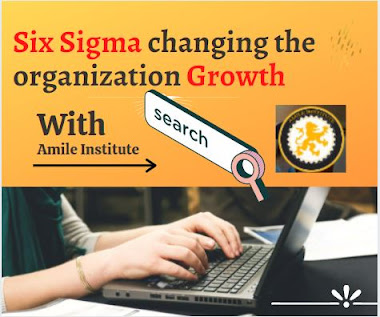Six Sigma Changing the Organization Growth - Amile Institute
The Defining,
Measuring, Analyzing, Improving, and Controlling method used in the existing
business has shown its importance and effectiveness in improving the business
and proving a healthy improvement. Six Sigma does have a different approach to
new processes, new services, or products as well. The new service is approached
in a way to Define, Measure, Analyze, Design, and Verify for a better start and
withstand the militant market.
This article
will help you understand how Six Sigma changes the organization process for the
better good. You can try registering in the Amile Institute for the Online Six Sigma green belt certification.
Cost management: The
greatest change Six Sigma can bring in an organization is the management of
production or operation costs. When delivering products or services effectively
and efficiently way is the primary goal of any organization, unwanted costs are
omnipresent. Six Sigma plays a vital role in avoiding or palliating these
costs. Six Sigma also makes sure that when the focus of reducing cost is a
primary factor, the quality of the products or service is not compromised.
Six Sigma
structure mainly focuses on Hard savings and Soft savings. Hard savings include
working with fewer employees and concentrating on how to reduce the budget.
Soft savings will focus on the costs that can be cut from the outcome of a
project. Overall, this helps in reducing the costs that are ineffective and
inefficient.
Retaining the customers: Customers
are the only reason an organization survives the militant market. Six Sigma is
more focused on the disappointed customers their issues and feedback to get
back with a better solution or alternate to save the organization from the
critics. Being customer-centric helps the organization retain and gain
customers. The process that Six Sigma follows makes the customer trust the
organization.
Minimal output errors: This
step is crucial because the output of your project speaks volumes about your
organization. Ensuring minimal errors when delivering a project is a mandate.
Six Sigma helps you attain this minimal output error by using three steps;
those are metrics, methodology, and philosophy.
These steps
involve predicting the possible errors that would occur during the process,
deciding on how to deliver the services to the customer, and making prior
arrangements or finding alternatives based on the customer expectations to make
sure the error is eliminated.
Employee centric: Bringing
up the ideas, working on them, giving results, working on the feedback, and
many more to make the organization work in the hands of the employees. The fellowship
between the organization and the employees will result in a better tomorrow.
Enhancing the process flow and being transparent to the employees are better
results of practicing the Six Sigma process.
Six Sigma
process helps in accessing not only the customers but also the employees to
make sure their needs to work as an individual and group are met. This process
also provides training and one-to-one sessions to achieve this.
Bottom line: Six Sigma
helps in improving the organization in every way possible. The yellow Belt Six Sigma Certification and Black Belt Six Sigma Certification are
beneficial to both employees and the organization.





Comments
Post a Comment